
How to apply Growth Hacking in 2024? The ultimate guide to boost performance!

What is Growth Hacking?

What is Growth Hacking?
The terminology has gained real momentum over the last decade, since its conception in 2010 by Sean Ellis. But what is growth hacking? (Clue, it has nothing to do with harming plants or cybercrime)
In its purest form, growth hacking refers to a set of strategies that scale the acquisition and retention of a company’s user or customer base. At its core, growth hacking was designed to help startups achieve massive growth using relatively low budgets.
This isn’t a one-size-fits-all scenario either. Growth hackers, the personnel responsible for driving this goal, can come from many backgrounds. An engineer can be a growth hacker the same way that a sales executive can. It’s really about having the right mindset.
Growth Hacking Definition

Growth Hacking Definition
Growth hacking uses multi-channel experimentation and analytical thinking to identify new growth opportunities that scale a business.
Sean Ellis describes a growth hacker as a “person whose true north is growth.”
What this means is that growth hacking is less concerned with following rigid procedures and more about creatively discovering how to expedite growth. Effective growth hacking can be applied at all stages of the customer journey too, from awareness to customer acquisition, marketing and distribution.
If through experimenting, a particular tactic works, voila! If it doesn’t, discard it and move on. Growth hacking is about optimisation and results, not process.
Digital Marketing vs. Growth Hacking

Digital Marketing vs. Growth Hacking
It would be reasonable to regard these two disciplines as the same, both digital marketing and growth hacking share a common goal of building user or customer bases and increasing profitability. However, the areas of focus and how they do this are where the distinction comes into play.
Digital Marketing and Digital Marketers
Digital marketing focuses on lead generation and conversions due to marketing a product through various digital channels. Typically a digital marketer will use social media, email marketing and content marketing strategies to build relationships with their customers and promote products.
When we consider a marketing sales funnel like this:
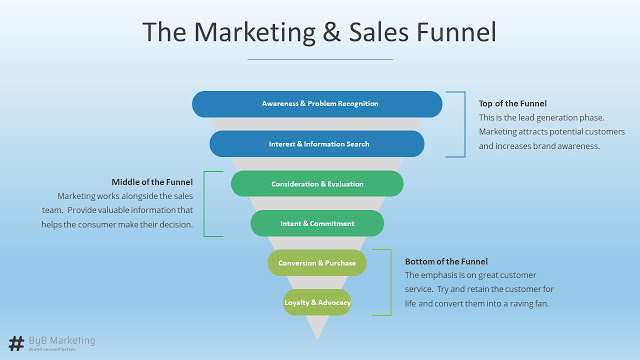
We can attribute the role of a digital marketer to the top of the funnel, the initial stages of creating brand awareness and generating interest in a product or service.
Digital marketers will regularly work on long-term projects and have financial resources to help drive results. Paid media and ad campaigns are commonplace for digital marketing departments whereas growth hackers can be expected to deliver results without the reliance on large advertising budgets.
When we talk about digital marketing methods, we’re referring to these key strategies:
Social Media Marketing
Creating digital content that promotes your product, increases awareness and engages your audience. This is distributed through social media channels like:
SEO Marketing & PPC (Pay-per-click)
Search engine optimisation (SEO) is the process of taking steps to place your website higher in Google’s rankings. Ideally on the first page. There’s a lot that’s involved in making this happen which we talk about in our Digital Marketing Ultimate Guide but it boils down to two types of SEO:
- On-Page SEO - building content that improves rankings
- Off-Page SEO - stuff that happens in the background, away from the website itself
PPC marketing is where a company pays an amount every time its ad is clicked online.
Email Marketing
The process of generating leads through promotional content like events and offers, as well as retaining audiences too. Typical types of email marketing are:
Content Marketing
The creation and promotion of content are used to attract, engage and retain customers. This includes:
Growth Hacking and Growth Hackers
So if a digital marketer is concerned with the “awareness” stage of the sales funnel, it would be fair to say that a growth hacker is involved in all of it. Because a growth hacker’s primary focus is to identify new growth opportunities, they have to be able to navigate every stage of the customer journey diligently.
Regardless of the department, a growth hacker seeks to grow the business. Heavily reliant on data, growth hackers tend to be tech-savvy people that aim to optimise conversions and use A/B (split) testing to find what works best.
Some examples of departments for growth hacking include:
Marketing
The creation and promotion of content are used to attract, engage and retain customers. This includes:
Product Development
The process of taking a product from concept all the way through to marketing and sale. Growth hackers run experiments at different stages of development to help refocus efforts on customer retention and engagement. Growth hackers use these sorts of tools:
Engineering
The process of creating, testing and managing a product’s development.
A growth hacker might look at the various stages of development and run experiments to speed the process up. What they’re looking for here, is the “product market fit.” A company’s work is complete when they have a product that perfectly meets the needs of its user.
Growth Hacking Methods

Growth Hacking Methods
Exponential growth and overwhelming success don’t just fall out of the sky. With that said, a few tried and tested growth strategies will help take your business from zero to hero if you apply the right amount of leverage. First, you’re going to identify the weakest points of your business and to do this, we refer back to the sales and marketing funnel:
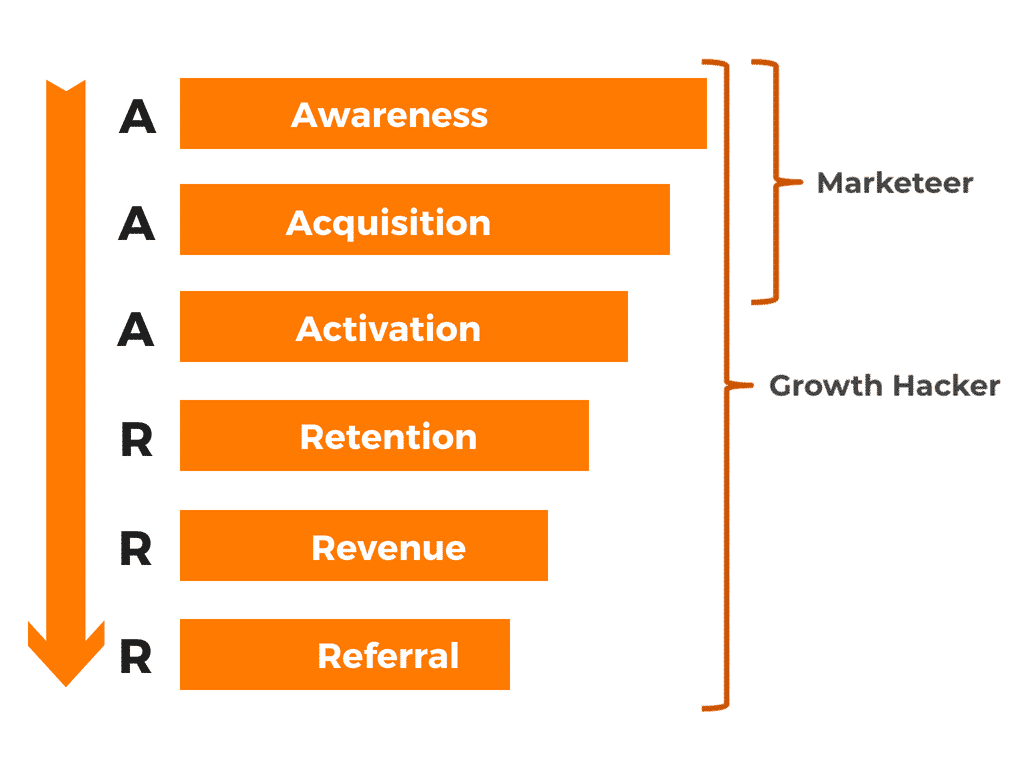
This funnel is what’s known as the AAARRR or Pirate Funnel. It represents the entire customer journey and all of the stages that a company must optimise. As the graphic illustrates, a growth hacker occupies every step of the funnel from awareness to referral. Each stage will be scrutinised using analytics tools and customer databases to figure out where the cracks are showing in the company.
Once we’ve established the weaker areas, growth hackers can focus their attention on finding out why conversions are dropping at a particular stage by:
- Conducting usability tests with customers
- Interviewing customers
- Analysing customer reviews
- Using heatmaps to see how customers interact with a website
Gathering data and feedback from real-world customers at this stage helps inform the next step: running experiments to find a solution. It has to be said, growth hackers run experiments like they’re going out of fashion. The goal is that every idea can be tested and iterated until the point of success. There’s no room for conformity here, growth hackers are obsessed with finding new ways to get fresh results.
And the best process to run growth experiments? *ahem*
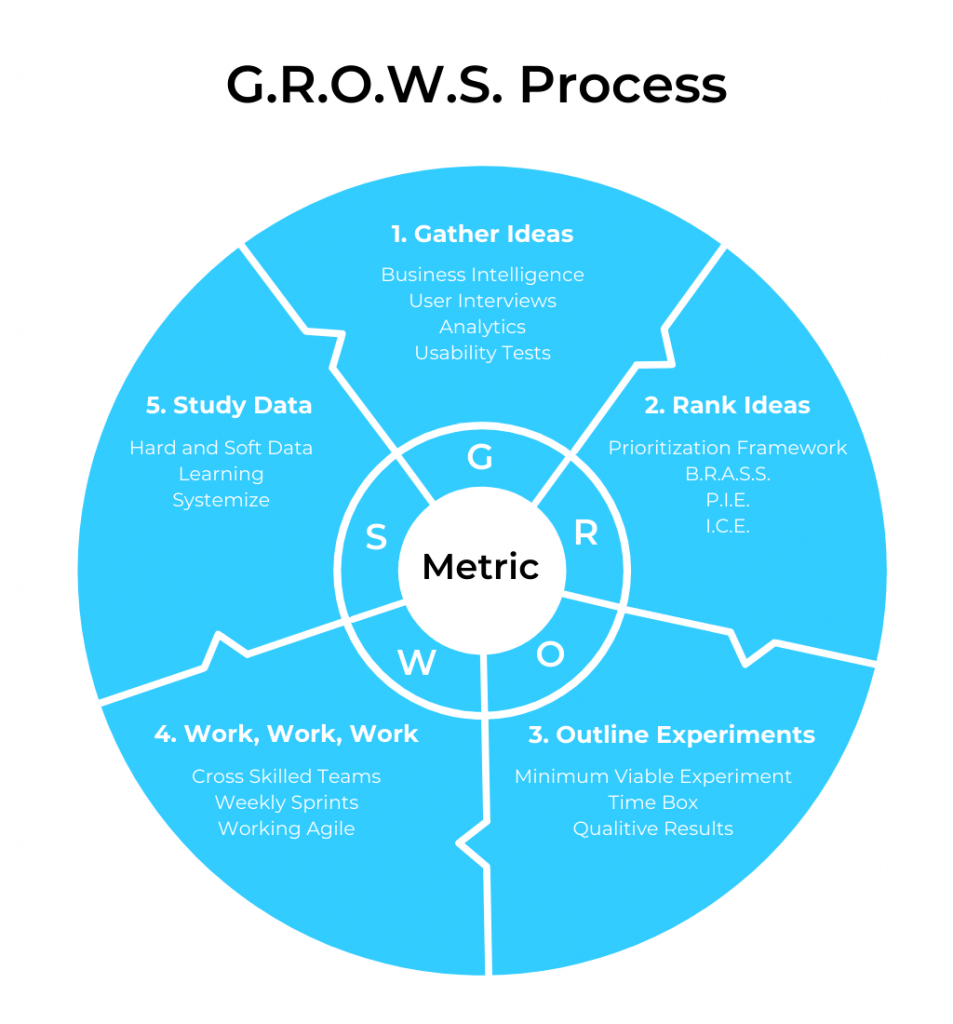
The G.R.O.W.S. process by Growth Tribe (that’s us!) is an industry-leading framework for running growth experiments. This 5-step solution is broken down into the following steps:
1. Gather Ideas
Rally the troops and collect as many ideas as possible. This step is about presenting solutions to customer pain points, and some useful ways to do this could be:
- Using heatmap tools to understand how users interact with your website
- Use competitor analysis to measure industry standards
- Involve all the departments and individuals for a wider perspective
- Get live feedback from usability tests
2. Rank Your Ideas
Because growth hackers don’t have access to unlimited investment, you’ll need to refine your list of ideas and rank them from best to worst. For ranking ideas, growth hackers use two frameworks:
- B.R.A.S.S. framework - which stands for Blink, Relevance, Availability, Scalability and Score. This helps growth hackers determine which acquisition channels to test first.
- P.I.E. or I.C.E. framework - which stands for Potential, Importance and Ease, and Impact, Confidence and Effort. This framework prioritises retention, referral and conversion optimisation.

3. Outline Experiments
Start thinking about which pain point you’re going to address and how you’ll solve it. For example, your landing page is receiving plenty of visitors but the conversion rate to download the free user tool is lower than expected. Analytics tells you that the sign-up form is a bit messy and unintuitive so you decide to change the form to see if that can boost conversions.
You now have a clear direction for where the team needs to focus their efforts.
4. Work, Work, Work
Contrary to popular belief, it’s not all we do… This is the stage where we gather our resources and the team members who will get to work making our ideas, a reality. A popular method at this phase is to implement “sprints”. Sprints are basically short, incremental cycles for creating and testing ideas to accelerate growth.
5. Study The Data
Now that the experiment has run its course, it’s time to collate the data and analyse it.
Present your findings to the team, who can make necessary changes, and to key members of management and potentially stakeholders too. If the experiment has proven successful then bravo! If not, it’s time to head back to the drawing board and restart the G.R.O.W.S. process.
Airbnb Growth Hacking

Airbnb Growth Hacking
Airbnb’s growth strategy is one of the most recognised examples of successful growth hacking. Revolutionising the travel industry is no easy feat and the journey was anything but, yet Airbnb overcame the naysayers through unwavering belief and innovation.
The humble beginnings of this $113 billion company (as of 2021) began in 2008, in San Francisco when founders Brian Chesky and Joe Gebbia, two former design school students, had the idea of renting out their apartment living room floor to travellers attending a nearby sold-out convention. This idea evolved into a website that got them their first few visitors. And that’s when things got clever.
Cereal-ously clever
To drum up funding for their new business model, Brian and Joe drew on their collective design experience to mock up two cereal boxes to be sold at political conventions.

We think you’ll agree these are something to behold. And at $40 bucks a box and 500 sales later, these breakfast parodies brought in some much-needed funding for the burgeoning startup.
Craigslist Integration
Around 2010, Airbnb knew that to grow the company they needed to reach more people, much more people. Craigslist was the perfect platform to achieve this goal. It had an established user base and was already known as a place where people go for hotel listings and accommodation. By posting their listings on Craigslist, it gave Airbnb a level of traffic that would have been almost impossible (or too time-consuming) otherwise.
Beyond that, the founders had to find a way to beat out their competitors, after all, there were hundreds if not thousands of people offering a similar thing. The first step was to manually (yes, manually) send an email to hosts asking them if they would consider listing their properties on the Airbnb site. Which saw moderate success but manual outreach is not sustainable long term. This led to the email sign-up process becoming automated.
Finding The Pain Point
This next bit takes us back to our Pirate Funnel, specifically, the acquisition stage. Brian and Joe concluded that the general quality of Craigslist listings was poor. The imagery was basic, misleading or downright shoddy. This was hurting rentals.
So, they bought a camera and set about taking professional quality images of a handful of properties. And It worked. Revenue more than doubled in a single month so they rolled the idea out and employed 20 photographers to do the same thing. This grew to 2,000 freelancers by 2012 and 13,000 properties across the globe.
Strength To Strength
Those ideas and savvy instincts, combined with a competitive pricing model that saw Airbnb listings somewhere between 30-80% lower than their peers, accelerated its growth at an unprecedented scale. As the company grew it added other initiatives like the “host score” where you can rate and review the property’s owner and other revolutionary changes to the travel industry as a whole.
Today, Airbnb sits around the $113 billion mark. It’s one heck of a story and a true testament to how growth hacking methods can shape a business.
Growth Hacking Examples

Growth Hacking Examples
Whilst the Airbnb growth hack is perhaps the best-known example of this, there have been numerous companies that have achieved a similar level of success using growth hacking methods. Here are a few of the best growth hacking examples you can learn from:
1. Dropbox
Dropbox is famous for being a leader in cloud storage solutions. They boast an impressive customer base of 500 million users worldwide. How did they do this? They gamified their onboarding process.
By rewarding the user for completing simple tasks, like connecting social media accounts or referring friends, Dropbox saw dramatic uptake in its services and user base.
2. LinkedIn
LinkedIn is unmatched when it comes to professional networking platforms. The major hook that got users to sign up initially, was this: when a user created a LinkedIn account, LinkedIn would make the person’s account visible on Google. They coded their way into Google which removed a huge headache for job seekers and companies trying to get seen on the world’s largest search engine.
3. Groupon
Using the power of FOMO (fear of missing out) and urgency, Groupon teased a deal for its users but on one condition; they only get that deal if a certain number of people share it. This meant they could reach new users seeing the deal being shared, and attract more sign-ups for future offers. Genius.
4. Hubspot
Hubspot is known for its prowess in marketing and software. They also happen to be one of the richest sources of free information and tools available. Giving away free tools that make life easier is a great way to get noticed but getting users to sign up via email first, is the real win here. This tactic helped Hubspot grow its email list exponentially which in turn, boosted conversions for tier paid tools.
5. Netflix
We can say with confidence that everybody on the planet has heard of Netflix. It's responsible for transforming the way we consume media. Removing the need to buy or rent DVDs of our favourite TV shows or movies and instead, stream them online instantaneously. Netflix grew to the company it is today due to the strength of its USP.
Best Growth Hacking Books

Best Growth Hacking Books
Growth hacking is a broad and versatile field that places a large amount of stock in its mindset. That being said, there are fundamental strategies that facilitate growth hacking success. In this chapter, we’ll look at some of the best growth hacking books you can read to prime you for success.
1. Hacking Growth
Co-written by Sean Ellis, the man who invented the term “growth hacking”, it’s no surprise to see him on this list. In the book Hacking Growth, Sean and co-writer Morgan Brown discuss the methodologies behind market-share growth with an accessible and practical toolkit that can be applied to any industry.
Hacking Growth is great if you’re just starting your growth hacking journey. It will help you grasp the fundamentals and guide creating your own growth strategy.
2. Traction
Traction by Gabriel Weinberg and Justin Mares explores the importance of consistency over originality or the strength of your team or how much money you raise. The book focuses on gaining and maintaining consistent traction to enable growth. Traction will teach you the nineteen channels used to build a customer base and helps you determine which is best suited to your company.
3. Growth Hacker Marketing
Growth Hacker Marketing by Ryan Holiday gives us an insight into his own experience shaping companies using growth hacking methods. This is a great book for beginners looking to gain the knowledge and understanding of what it means to be a growth hacker and the techniques that can be used to accelerate growth.
4. Hooked
Hooked, by Nir Eyal, explores the relationship between products and consumers, more specifically, how we can build habit-forming products that drive better engagement and retention from our customers. In this book, Nir details his four-step process that when embedded into products, helps to drive these positive customer habits.
5. Growth Hacking
Growth Hacking by Raymond Fong and Chad Ridderson explains in simple terms exactly how growth hacking methods have been used to reap massive success in Silicon Valley. Using their own ASP framework, the pair offer a blueprint on how to apply cost-effective solutions to drive growth and marketing for your business. As well as the mindsets and philosophies often referred to in growth hacking circles.
Best Growth Hacking Podcasts

Best Growth Hacking Podcasts
As with any new skill you’re looking to develop, it can be frankly overwhelming attempting to sift through all the digital literature available online. Luckily, podcasts are here to make learning growth hacking a little easier, with entertaining and value-packed content in digestible stints.
Read on for our list of the best growth hacking podcasts.
1. The Growth Hacking Podcast
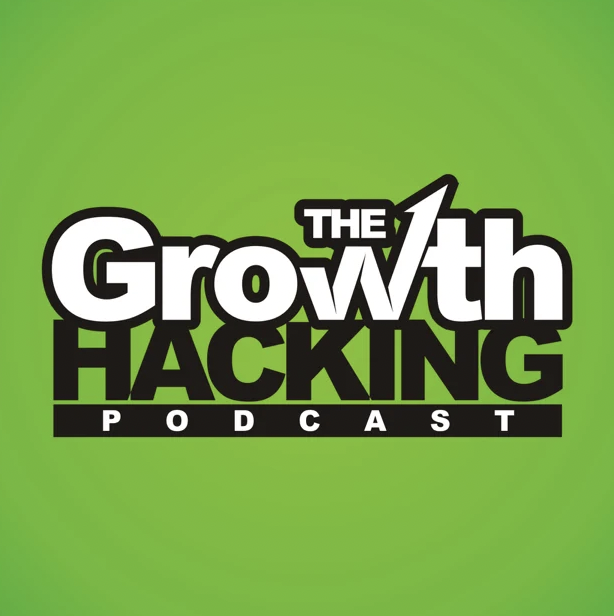
The name says it all! The Growth Hacking Podcast is a bi-weekly show hosted by Laura Moreno about all things growth hacking. On it, Laura interviews successful growth hackers and startup founders who share their winning strategies. The end of each episode features a Lightning Round where guests divulge their greatest secrets for success.
2. Growth with Matt Bilotti
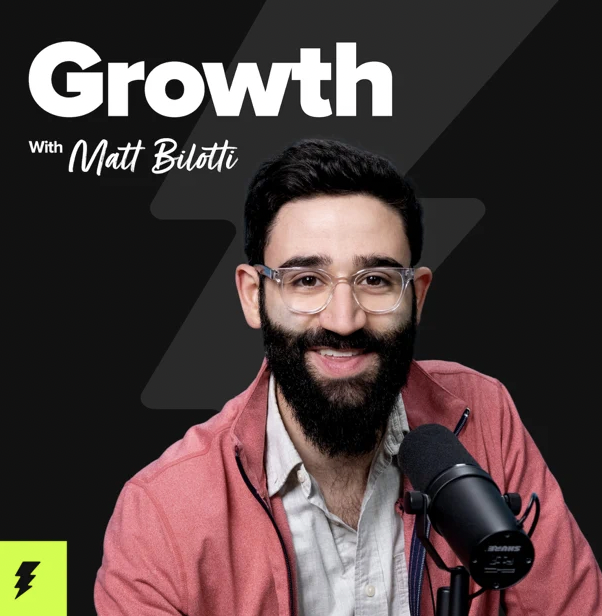
On this bi-weekly podcast, our host sits down to talk about all things growth. From strategies to tactics and channels. Growth with Matt Bilotti uncovers insights from big players like Shopify, Disney+ and Github.
3. The Growth Show

The Growth Show sees our host, Meghan Keaney (VP of marketing at HubSpot) explore the inspiring stories surrounding growth hacking across different industries.
The range of stories and examples on display make this a great listen for up-and-coming growth hackers.
4. The Growth Experts Podcast

The Growth Experts with Dennis Brown invites top CEOs, marketers and entrepreneurs to share their strategies and tools for growth success.
The show is all about digging deep into the various tactics that have worked for companies, and the ones that didn’t too!
5. Growth Marketing Toolbox

The Growth Marketing Toolbox switches the focus slightly from growth marketing strategies and tactics to giving tips for which tools you should be using to get there.
The show interviews marketers, founders and product creators to lend their growth hacking insights.
Best Growth Hacking Blogs

Best Growth Hacking Blogs
For those opportunities where you do get a few moments to yourself, fire up the browser and check out these growth hacking blogs to nourish that curiosity!
Whether it's a quick insight or a lengthy case study, growth hacking blogs will help broaden your knowledge and you can mine them for tips and tricks too.
Read on for our list of the best growth hacking blogs.
1. Growth Tribe

Growth Tribe is Europe’s first growth digital learning platform to educate and equip companies, and people, with the tools and skills to grow and succeed.
They offer blogs on a variety of digital marketing, analytics, UX design and much more.
2. HubSpot

HubSpot has positioned itself as a go-to resource for marketers’ burning questions.
Whether it’s writing a blog, launching a digital marketing campaign or understanding the sales process, HubSpot will have an answer for you.
3. UserGuiding

UserGuiding offer flexible software to solve user onboarding processes. Their blog features great articles on business intelligence, data science and other valuable growth-minded skills.
4. Growth Hackers

The Growth Hackers blog is a platform where growth marketers and hackers share and interact with each other.
Although typically shorter reads, you’ll find virtually every type of growth-related content here.
5. Reforge

Brian Balfour’s Reforge blog shares insights from contributors concerned with all things growth. You can expect articles on strategy, business sense, finance and more.
Growth Hacker Jobs

Growth Hacker Jobs
Now that you’ve taken your first steps into the world of growth hacking, you might be curious as to the types of jobs and roles you can expect to find. One of the positives about growth hacking is its cross-functionality. Unlike other creative roles, you’re not pigeonholed into a specific department, instead, you bridge the gap between them such as sales teams, web developers, engineers, product teams and upper management.
Check out these listings from LinkedIn for examples.
A typical growth hacker job description will look something like this:
Growth Hacker Responsibilities
- Understanding long-term business goals
- Defining the weaker areas of the business
- Managing growth-oriented goals
- Identifying new growth opportunities
- Creating and testing experiments to encourage growth
- Creating projects and campaigns for growth
- Interpreting data and analytics to inform business decisions
- Reporting on initiatives and projects to senior management
Growth Hacker Requirements
- Previous experience in Marketing, Business Management or similar
- Applicable knowledge of HTML5, JavaScript and CSS3
- Experience with analytics tools and A/B testing
- Knowledge of UI/UX design
- Copywriting and editing skills
- Applicable knowledge of sales funnels and growth methods
- Obsessively curious and growth-minded
So, growth hackers have plenty of soft and technical skills, something they share with T-shaped marketers.
This is where a person has a broad understanding of many skills but specialises or has a deep understanding of just a few.
Check out growth hacker jobs near you at these sites:
Final Thoughts

Final Thoughts
By now you’ll have learnt some of the fundamentals of what it takes to become a growth hacker. This guide serves as an introduction to one of the most creative and innovative roles out there.